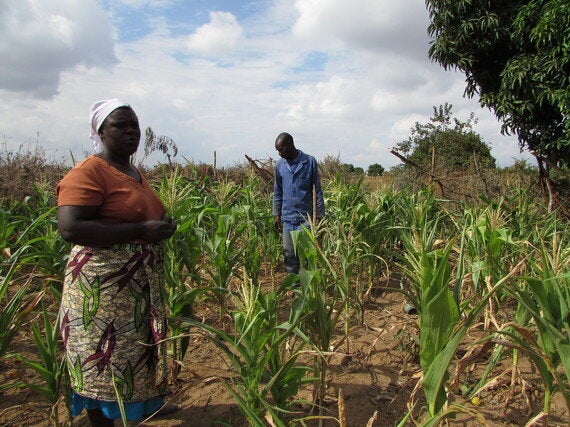
East and Southern Africa is suffering a terrible drought as a result of El Nino. Zimbabwe is one of the most badly affected countries with an estimated 4.2 million people - over 1/4 of the population - considered likely to be hungry by the peak hunger period of January to March 2017.
I visited some of the worst affected parts of southern Zimbabwe and was shocked by just how dry it was. The soil has turned into sand and is blowing away. We were told by communities in Mberengwa that they had not seen rain since January 2016. Government agriculture officials said the villagers last managed to have a meaningful harvest in 2009.
This affects the poorest people worst, because they depend on their own small farms for most of their food and income. And you can't grow food without water. It affects children especially. Infants who are malnourished in their first two years of life will always be disadvantaged. They have worse health, lower educational attainment - paying school fees is difficult for most rural communities - and lower wages as adults than children who get a good start in life.
Zimbabwe needs to manage water resources better to reduce the impacts of droughts, which will increase with climate change. CARE is addressing this through the construction of small dams which gather run-off water during the rainy season which can then be used in food gardens all year round. But in the meantime, people need extra help now.
Life-saving cash
In order to help the very poorest and hungriest people in Zimbabwe, the UK government has asked CARE to lead a programme - working with World Vision - to provide small monthly cash payments by mobile phone or SIM cards to over 72,000 families (360,000 people) so that they can afford the minimum necessary food to avoid malnutrition.
Providing humanitarian emergency aid as cash instead of traditional CARE packages of food is relatively new, especially in Zimbabwe. But CARE's long history of promoting Village Savings and Loan Associations, and using mobile phones to transfer money, means that we know just how powerful it is to put cash in the hands of poor people. No-one knows better than them what they need - they just lack the money to buy it.
How does it work?
The first thing we have to do is decide which families most need the help. First, we work out - in consultation with the local authorities - which wards are most short of food. A 'ward' is the smallest administrative unit in Zimbabwe. A ward will typically have a population of a few thousand people and in rural areas will contain a few villages.
Our CARE team then visits each of those wards and assesses each household against a number of criteria - for example, crop harvest below 50kg of cereal, households with pregnant or lactating mothers and other high nutrition needs, households with below average income, child-headed households with no support.
How does it help people?
The programme targets the poorest 10-15% of population in the most drought-affected areas. In the village in Mberengwa I visited, 50% of families qualified as very vulnerable. So you can see that it was a very hungry village.
One woman, Catherine Chikunya, aged 67, told me there were six people in her house. In the past, aid from CARE used to be in the form of bulgur wheat, peas and oil. She said receiving cash allowed them to buy a more varied food basket resulting in a more nutritious diet. And she was planning to buy seeds in October 2016 ready for planting, if the rains come this season.
Another woman told us that she had used her September 2016 transfer to buy 50kg of maize meal - the staple diet in Zimbabwe - 5kg of beans and 5 litres of cooking oil. That is what they'd eat for the month. Additionally, she was able to pay the school levy for one of her children.
How much money do people get?
$5 per person per month - which is a LOT less than the $1.25 a day that is seen as the global extreme poverty line. Clearly, this amount cannot cover the full cost of people's food needs, but it is meant to be enough to ensure the family can afford those needs by topping up the small income and food production they still have.
We monitor food prices every two weeks, and because of rising prices, we decided in August 2016 to increase the amount from $5 per person per month to $7 per person per month. And in October,
DFID (the UK government Department for International Development) provided a one-off top up.
At this time of year families are expected to pay school fees. It is also planting time. So in order to grow food in the coming months, they need money to buy seeds now. Because it's cash, it's up to them how they use this additional payment. But people in the village we met in Mberengwa district confirmed that school fees and seeds is how they would use it.
How do people get the money?
Each month, the payments are made by electronic transfer to a SIM card. If people already have a mobile phone, we use that number. If people didn't have a mobile phone, CARE negotiated with the mobile companies so people could buy a SIM card for just 25 cents, instead of the normal price of 50 cents. They can then borrow a mobile phone, or use the mobile phone company agent's phone, to 'cash out' their electronic transfer - in other words, exchange the electronic voucher on their phone for money.
How do we know it's working?
Communities in Bvute ward of Mberengwa district told us that they were receiving their money as expected. But we don't just rely on individual anecdotes. Every month we survey 2% of the households in the programme. That's 1,500 families. As a result, we know that over 90% of cash transfers are used to purchase food.
We know that in October 2015, 12% of families were suffering severe hunger, and 51% moderate hunger. By June 2016, none were suffering severe huger, and only 10% moderate hunger.
And we know that another impact of the project has been the increase in women's control of household budget. The increase in women deciding household spending probably contributes to spending the cash transfer on food.
When you have very little money you need to be very good at managing it to survive and prosper. Access to financial services can help people to save money for future use. This means they can be more resilient when they are hit with a shock, such as a medical bill or a poor harvest. It also means they can pay for bigger items like school fees, or invest in small business ideas to increase their income - and so start a virtuous cycle out of poverty.
